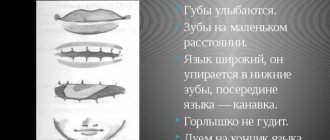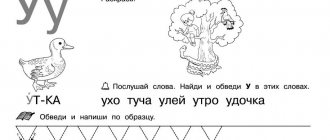Beautiful and competent speech has always been valued in society. Sometimes the ability to speak correctly helped people achieve career heights or made them famous throughout the world. However, none of us even thought about the fact that this skill is laid down in childhood. But what should those whose child cannot pronounce some letters do? Are there really no ways to correct this speech disorder? As it turns out, there is. We decided to study the problem of pronouncing the sound “r” in children, find out how speech develops in children and how this process can be facilitated. Speech therapist Vita Bilukha helped us with this.
Reasons for incorrect pronunciation of the sound “r”
Many children, as they grow older, begin to experience discomfort due to the incorrect pronunciation of certain sounds. Peers begin to tease, which ultimately leads to the development of complexes and self-doubt. In addition, deficiencies in oral speech also affect written language, which, in turn, greatly reduces academic performance. But why do such speech disturbances occur?
According to the expert, pronunciation disorders can either be independent or act as one of the manifestations of a more complex disorder of sound speech. Various shortcomings in the pronunciation of the sounds “r” and “r” are expressed in their distortion or replacement. The main reasons, according to the speech therapist, are:
• shortened sublingual fold (“frenulum”), limiting upward movements of the tip of the tongue and the anterior part of the back of the tongue;
• weakness of the tongue muscles;
• inability to perform involuntary, purposeful movements with the tongue;
• phonemic hearing disorder - the child’s inability to distinguish heard phonemes.
In addition, we learned that teeth can also influence the quality of pronunciation of various sounds. According to the specialist, an incorrect bite only complicates the work and increases the time it takes to correct speech defects:
• with an open bite (when the teeth do not meet), interdental pronunciation often occurs;
• with a lateral bite, sounds may be pronounced with an unpleasant squelching sound;
• with a deep bite (the lower jaw overlaps the upper jaw), the production of the sound “r” is often combined with a high and narrow palate, which greatly complicates the correct pronunciation.
“If the child has no other speech disorders, except for the incorrect pronunciation of the sound “r”, then this is a difficulty in his articulation. Therefore, parents should not panic if their child does not “growl” at three years old. The articulatory apparatus must be prepared.”
Particular attention should be paid to phonemic hearing impairment. This is a rather serious problem, which will subsequently lead to a deterioration in the child’s performance at school, since the perception of oral and written speech is greatly affected by this disorder.
Reasons for violation
Speech problems arise in a child for various reasons. If only the pronunciation aspect of speech is impaired, that is, the preschooler does not pronounce one or more sounds, then this is dyslalia.
Such a conclusion is made only after a detailed examination. The child's hearing acuity and muscle mobility of the speech apparatus are checked. If both components are normal, dyslalia is diagnosed.
It appears due to two main groups of factors. With the first, there are no deviations in the structure of the peripheral speech apparatus. The disorder is called functional dyslalia. It appears due to biological problems:
- frequent illnesses;
- problems during pregnancy and childbirth;
- minimal brain dysfunction.
It is impossible to establish exactly what became the catalyst for the violation. The social environment influences the formation of speech. Parents can deliberately distort speech, use primitive babbling words and lisp. All this does not contribute to correct sound pronunciation.
In dysfunctional families, there is limited contact. The child does not communicate with peers or adults. The formation of speech occurs not only during the perception of spoken words, but also the ability to use them. Without practice, there will never be pronunciation skills.
Mechanical dyslalia occurs due to disturbances in the structure of the articulatory apparatus. Sonoras (sounds “R”, “L” and soft pairs) require raising the tip of the tongue. A short hyoid frenulum limits the mobility of the organ.
It is easy to check the length of the ligament at home: the child is asked to open his mouth and lift his tongue. A small thin strip is visible from the bottom of the oral cavity to the organ - this is the frenulum. If it is short, then the tongue will not rise or will come off slightly from the lower jaw.
In rare cases, problems arise due to a high palate. This is a congenital anomaly. Bite problems do not affect the pronunciation of sonorous sounds.
There is a concept of age-related dyslalia. Groups of sounds appear at different periods - this is normal development. Sonoras are formed at five years of age. Until this moment, you don't have to worry.
When to contact a specialist
As the speech therapist told us, the articulatory apparatus is fully formed by the age of four to five years. And if by this time the child does not pronounce the hard sound “r” and the soft “ry”, then this may be a good reason to contact a specialist. She clarified that the sound “r” is considered one of the most difficult and its production requires preparatory work.
Now we will explain why the sound is complex. If you remember your school years and Russian language lessons, then you will probably remember a sign with voiced and voiceless consonants. But “r” always stood in a separate column - sonorant sounds. They were the ones who did not have a deaf pair and were distinguished by the fact that they were pronounced with a distinct and ringing expression in the voice. According to statistics, preschoolers at the age of four can pronounce all sounds except sonorant ones.
What happens when we pronounce the sound "r"? Here's what:
• lips are in a relaxed state;
• a space of four to five millimeters is formed between the teeth;
• the tip of the tongue at this time rises to the upper gums;
• due to the flow of air, the tongue begins to vibrate;
• the middle part of the tongue arches, and the back, on the contrary, is pressed against the palate;
• along the edges of the tongue is pressed against the upper teeth;
• vocal folds fluctuate at the moment of pronunciation.
Therefore, the following types of pronunciation are considered deviations from the norm and necessarily require correction by a qualified specialist:
• Velar - the tip of the tongue moves down during pronunciation and does not take part in articulation. There is a lot of tension in the tongue itself, causing it to move back. The pronunciation itself occurs not with the help of the voice, but with the help of air, which means the sound is guttural;
• Uvular - the tongue begins to vibrate in the resulting stream of air. The sound is very quiet and soft;
• Nasal - from the name you can understand how the sound itself is produced. This pronunciation is characterized by localization of air in the nose and a complete absence of vibration;
• Bilabial - in this case, only the lips take part in the formation of sounds, the tongue is not involved in any way;
• Slit - the tongue is directed upward, when speaking it forms a gap with the soft palate;
• Interdental - the tongue is located between the teeth, due to which the pronounced sounds are greatly distorted.
From the personal archive of Vita Bilukha /
Interesting facts about the letter P
What is interesting is that in the Old Church Slavonic language this letter could be both hard and soft, and sometimes even a syllable-forming unit. Another interesting feature and mystery of the “R” is that the sounds for the letter “r” are so dissimilar that if necessary, you will have to memorize all these different letters “r”.
It is interesting that this letter itself carried not only a semantic load, but also an emotional vibration, a certain psychological message personifying the power of vibrations and/or energies.
If we take into account the two main languages of the European part of the world, we can trace the trend of two developments of the letter “r”. It is either pronounced distorted or not pronounced at all. Where it came from and how it appeared is one complete mystery!
The letter “r” gained particular fame thanks to the French language. There, two varieties of a given letter can simultaneously exist: anterior lingual and uvular. The front-lingual letter “r” is no different from our ordinary letter “r”, while an example of uvular sound is French speech and its soft, palatal, slightly burred pronunciation.
An interesting fact is that they begin to realize a special relationship to this letter as children grow up. The most common reason for turning to specialists is the production of this particular sound in early childhood.
Children often do not understand how to master this obstinate sound, replacing it with the easier to pronounce “l”. But everything is simple! You just need to know the entire articulatory structure, consisting of the position of the lips, tongue, and soft palate.
Speech correction process
As we said earlier, the process of correcting the pronunciation of the sound “r” always requires preparation. According to the speech therapist, the preparatory period is based on articulatory gymnastics for the lips and tongue. She clarified that you need to do articulatory gymnastics every day for five to ten minutes. Examples of basic exercises for making the sound “r”:
• “Brushing your teeth” - lips smile, with the wide tip of your tongue you need to imitate movements like when using a toothbrush. And thus “clean” your upper teeth.
• “Cleaning the palate” - with a broad tongue you need to make a forward and backward movement.
• “Fungus” - the child sucks his tongue to the roof of his mouth.
• “Accordion” - the tongue is in the “Mushroom” position, while the lower jaw must be moved up and down.
• “Horse” - the child imitates the clatter of hooves. You need to click slowly and your tongue should be wide. It is important to consider that the lower jaw should not move.
• “Machine Gun, or Drummer” - lips are in a smiling position. Repeat the sound “D-d-d” quickly and repeatedly, pressing the tip of your tongue firmly against your teeth to make a distinct sound.
• “Swing” - you need to open your mouth, stick out your tongue and alternately stretch it to your nose, then to your chin.
• “Football” - the mouth is in a closed position, the lips are closed. At this time, you need to forcefully press the tip of your tongue into one or the other cheek.
The next stage in establishing the correct pronunciation of sounds is the formation of speech breathing. This is a very important nuance, since it is speech breathing that is responsible for voice-forming and articulatory functions. If breathing is correct, then the child speaks clearly and beautifully.
“To create a strong oral exhalation, you can use the following exercises: blowing out a burning candle, blowing into water through a cocktail straw (to make the water bubble), blowing a pencil or piece of cotton wool off the table, blowing soap bubbles, and inflating balloons.”
Speaking about this stage, the speech therapist talked about the tricks that will help develop the correct pronunciation of the sound “r”:
• The first method comes from the “Mushroom” exercise that we talked about earlier. When the tongue is in the desired position, the child exhales forcefully onto the tip of the tongue. When you exhale forcefully, you should experience vibration.
• the second method is mechanical. It is best to perform it while lying down. The child performs the “Machine Gun” exercise, and one of his parents or a speech therapist makes oscillatory movements under the tongue with a cotton swab. It should be "dr".
At the same time, the specialist noted that very often parents make mistakes when automating the sound “r” at the moment when they try to play it at home.
“It is possible to install sound at home, but it does not always end successfully. It’s better to seek advice from a speech therapist in a timely manner and then together develop an action plan.”
In the event that you nevertheless decide to start staging the correct speech of your child yourself, then we decided to share with you a couple more techniques.
If the baby has a good and clear sound “zh”, then with its help you can try to pronounce the sound “r”. To do this, the child needs to clearly and loudly pronounce the sound “zh” for several minutes, then ask him to move his tongue a little deeper and pronounce the same sound. This allows you to make a short, punch-like “r” sound. If the child succeeds, the exercise should be repeated several times, and then the pronunciation of the sound should be automated and composed of paired phonemes.
Another way is to put “p” through “s”. It is also important here that the child does not experience difficulties when pronouncing the unvoiced sound “s”. The method can be called non-standard, since it is performed while inhaling, while all our sounds are pronounced while exhaling. Yes, this method may seem complicated at first, but don’t be scared. Ask your child to pronounce the sound “sss” for a long time, after which he needs to press his tongue against the tubercles behind the upper teeth (alveoli) and inhale through his mouth. If the exercise was done correctly, then you will hear the short and treasured “r” sound.
All of the above methods are very effective and have helped more than one child. Do not forget that such exercises may seem difficult for a child, so try to present everything in the form of a game, constantly praise and encourage the child.
pexels.com/
Forms of rhotacism
Parents rarely hear defective sound. An experienced speech therapist will immediately identify it. It is rare to encounter a complete absence of the soft sound “R”. In this case, the child will say “tsa” instead of “king.”
Burr is called velar pronunciation. Due to the vibration of the soft palate, excess noise appears and the sound is distorted. With the uvular form, a small tongue works.
With lateral pronunciation, the vibration does not go to the tip of the tongue, but to its lateral edges. The form is characteristic of dysarthria, structural defects of the speech apparatus (short hyoid ligament).
In the bilabial form, the sound is created by trembling the lips, resulting in the combination “prrrrr”. It is sometimes called "coachman's".
Sometimes a child is able to say a single-beat “R”, in which case there is no tongue fluctuation. The output sounds distorted "D".
“Рь” can be replaced by different sounds: hard “R”, “L”, “Y”, “D” and others.
Producing the sound “r” in adulthood
It's no secret that many adults cannot pronounce the letter "r". Agree, listening to such a speech is quite difficult. But it is much more difficult for those people whose speech has some defects. In this regard, we asked the speech therapist the appropriate question: is it possible to correct sound pronunciation in adulthood? According to her, it is difficult, but possible.
The expert noted that it is possible to teach a child to pronounce a sound in isolation at any age; the difficulty lies in automating the sound.
“In kindergarten, everyone is on an equal footing, some learn to hiss, some to buzz, some to growl, and this is perceived quite naturally. At an older age, a completely different situation arises. A new sound, especially “r”, stands out in speech at first, so the child is embarrassed to use it in public. A student can speak well at home or in a speech therapist’s office, but in class or in the company of friends it is very difficult for him to switch to correct speech.”
At the same time, automation of sounds at an older age requires a lot of motivation from the child and good support from adults. As a result, the sound seems to be there, but it’s as if it’s not there. Therefore, she advised young parents to take timely care of their child’s speech and, if necessary, contact a specialist who will help correct the existing defect in the child’s speech.
Staging methods
A soft sound is placed after the introduction of a hard sound into speech - this is the traditional view of speech therapists. In some cases this cannot be done. Therefore, you can start delivery with “Ry”.
The techniques are standard: from other sounds or mechanically. For the latter, a probe or probe substitute is needed. The tool looks like a stick with a ball at the end. As a replacement, use skewers for canapés with a ball at the end, or a spatula with a silicone nipple.
Sound production is carried out in a lying position. The child opens his mouth, raises the tip of his tongue, quickly pronounces “D”, the speech therapist shakes the tongue with a probe, resulting in trembling.
When setting up sonors, it is allowed to start automation with syllables immediately.
The production of the sound “Th” has its own peculiarities: the sound is pronounced in an exaggerated, drawn-out manner, the lips are elongated in a smile. The child is asked to say “t-r-i.” A new sound will be heard, which is indicated by a symbol.
It is effective to set the sound from “Зь”. To do this, the preschooler is asked to sing a mosquito song, but with the tip of the tongue raised up to the alveoli. The distorted sound is corrected by the movements of the probe and a drawn-out “zi” is pronounced, which turns into “ri”.








